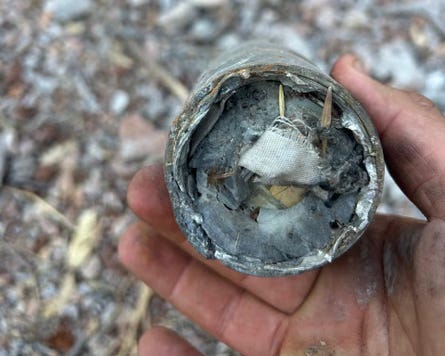Israel Uses New Banned Cluster Munitions in South Lebanon
Six weapons experts confirm the Israeli army used newly developed Barak Eitan and Ra’am Eitan cluster munitions, deepening humanitarian fears as unexploded submunitions continue to endanger civilians.
Palestine, PUREWILAYAH.COM - The Guardian has confirmed, through analysis by six independent weapons experts, that “Israel” used two newly developed cluster munitions in its recent attacks on South Lebanon.
Verified images from Wadi Zibqeen, Wadi Burghuz, and Wadi Deir Siryan show remnants of the 155mm M999 Barak Eitan artillery round and the 227mm Ra’am Eitan guided rocket—marking the first documented use of cluster munitions by “Israel” since the 2006 July War.
These findings also represent the first known instance of “Israel” deploying these newer models, both produced by Elbit Systems.
Global Treaty Bans Cluster Munitions, but ‘Israel’ Refuses to Adhere
A total of 124 countries have joined the Convention on Cluster Munitions, which prohibits the use, production, and transfer of these weapons due to their indiscriminate and long-lasting danger to civilians. “Israel” is not a party to the treaty.
Tamar Gabelnick, director of the Cluster Munition Coalition, stated that cluster munitions are inherently incompatible with international humanitarian law due to their wide-area impact and the decades-long threat posed by unexploded bomblets.
“These weapons cannot distinguish between civilians and combatants,” she said.
Lebanon remains one of the countries most devastated by cluster munitions. In 2006, “Israel” released four million submunitions, with an estimated one million failing to detonate. Since then, more than 400 Lebanese civilians have been killed by unexploded bomblets.
The vast contamination of South Lebanon was a driving factor behind the creation of the 2008 Convention on Cluster Munitions.
Images of the M999 Barak Eitan were authenticated by six weapons specialists, including Amnesty International’s crisis research chief Brian Castner and analysts from Armament Research Services.
The advanced shell disperses nine submunitions, each exploding into 1,200 tungsten fragments, according to U.S. Army documentation.
Five experts verified that images of a second munition were cluster remnants. Two analysts identified it as the 227mm Ra’am Eitan guided missile, produced in 2017. Israeli media describe the weapon as carrying 64 submunitions, capable of saturating a wide area with lethal explosions.
A 2024 Israeli army statement confirmed that forces along the northern border had been equipped with Ra’am Eitan rockets for use against Hezbollah.
Israeli Claims on “Low Failure Rates” Contradicted by Reality
Israeli defense industries claim these newer cluster munitions have extremely low failure rates—0.01% for the Ra’am Eitan and similarly low rates for prior models. However, historical assessments have shown such claims to be false.
For example, the M85 submunition used by “Israel” in 2006 was advertised with a failure rate of 0.06%, yet post-war analysis placed the true rate at around 10%.
Weapons specialists and human rights organizations agree that no cluster munition can be used in a manner that avoids civilian harm.
“Cluster munitions are banned internationally for a reason,” Castner emphasized.
“Their use is inherently indiscriminate. There is no lawful or responsible way to deploy them—and civilians pay the price for decades.” (PW)


